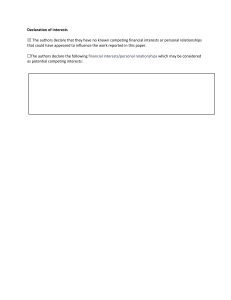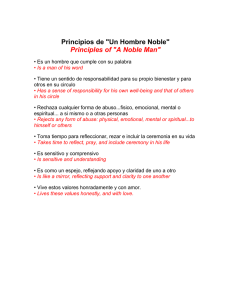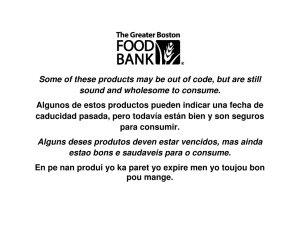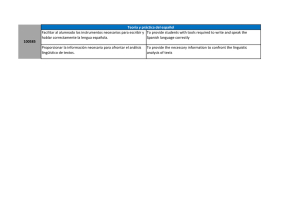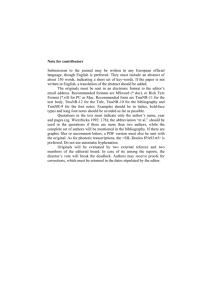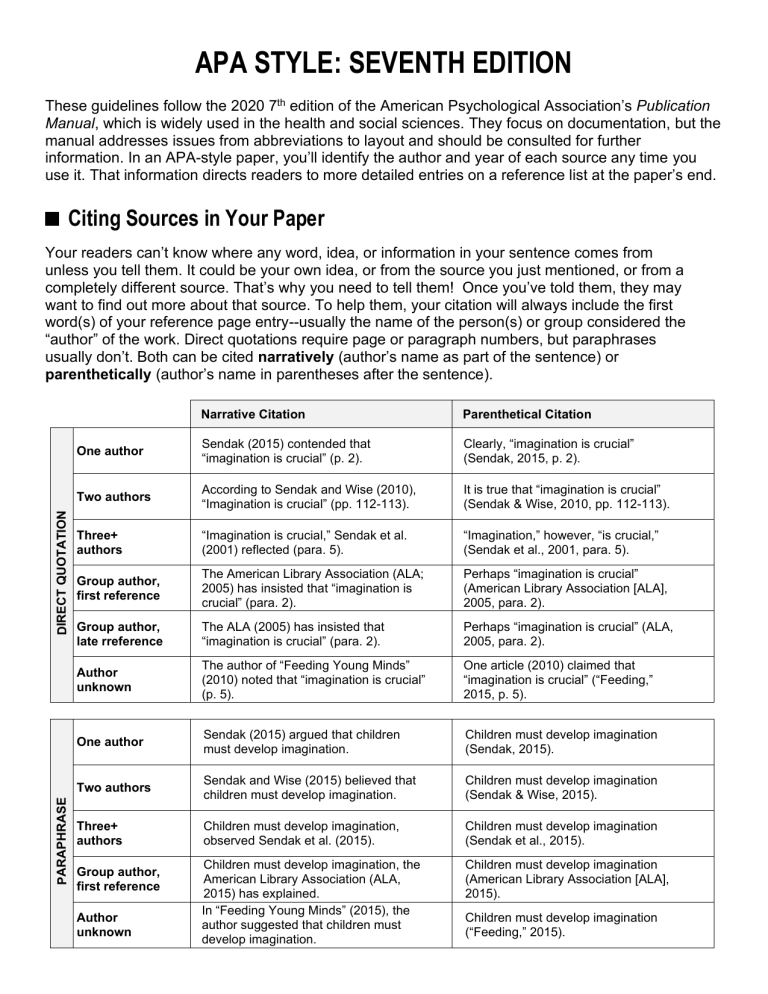
APA STYLE: SEVENTH EDITION These guidelines follow the 2020 7th edition of the American Psychological Association’s Publication Manual, which is widely used in the health and social sciences. They focus on documentation, but the manual addresses issues from abbreviations to layout and should be consulted for further information. In an APA-style paper, you’ll identify the author and year of each source any time you use it. That information directs readers to more detailed entries on a reference list at the paper’s end. ■ Citing Sources in Your Paper PARAPHRASE DIRECT QUOTATION Your readers can’t know where any word, idea, or information in your sentence comes from unless you tell them. It could be your own idea, or from the source you just mentioned, or from a completely different source. That’s why you need to tell them! Once you’ve told them, they may want to find out more about that source. To help them, your citation will always include the first word(s) of your reference page entry--usually the name of the person(s) or group considered the “author” of the work. Direct quotations require page or paragraph numbers, but paraphrases usually don’t. Both can be cited narratively (author’s name as part of the sentence) or parenthetically (author’s name in parentheses after the sentence). Narrative Citation Parenthetical Citation One author Sendak (2015) contended that “imagination is crucial” (p. 2). Clearly, “imagination is crucial” (Sendak, 2015, p. 2). Two authors According to Sendak and Wise (2010), “Imagination is crucial” (pp. 112-113). It is true that “imagination is crucial” (Sendak & Wise, 2010, pp. 112-113). Three+ authors “Imagination is crucial,” Sendak et al. (2001) reflected (para. 5). “Imagination,” however, “is crucial,” (Sendak et al., 2001, para. 5). Group author, first reference The American Library Association (ALA; 2005) has insisted that “imagination is crucial” (para. 2). Perhaps “imagination is crucial” (American Library Association [ALA], 2005, para. 2). Group author, late rreference The ALA (2005) has insisted that “imagination is crucial” (para. 2). Perhaps “imagination is crucial” (ALA, 2005, para. 2). Author unknown The author of “Feeding Young Minds” (2010) noted that “imagination is crucial” (p. 5). One article (2010) claimed that “imagination is crucial” (“Feeding,” 2015, p. 5). One author Sendak (2015) argued that children must develop imagination. Children must develop imagination (Sendak, 2015). Two authors Sendak and Wise (2015) believed that children must develop imagination. Children must develop imagination (Sendak & Wise, 2015). Three+ authors Children must develop imagination, observed Sendak et al. (2015). Children must develop imagination (Sendak et al., 2015). Children must develop imagination, the American Library Association (ALA, 2015) has explained. In “Feeding Young Minds” (2015), the author suggested that children must develop imagination. Children must develop imagination (American Library Association [ALA], 2015). Group author, first reference Author unknown Children must develop imagination (“Feeding,” 2015). 1. Dates. APA includes the year of publication in every parenthetical citation and in the first narrative citation of each source in any paragraph (although some teachers require it in all narrative citations). Only the year of publication goes in your in-text citation, even if the reference page entry includes a month. Manual, p. 262. 2. Page numbers. APA requires specific page, paragraph, or location numbers for all direct quotations. Specific page numbers are rarely included for paraphrases and most teachers don’t allow them, although APA does. List all digits in every page number. For written sources without page numbers, use “para.,” the paragraph number, and, when possible, the section heading. Put document-specific headings in quotation marks and shorten them if needed. For video or audio sources, use the timestamp; for PowerPoint presentations, use the slide number. Manual, p. 264. (Drew, 2002, para. 4) (Marvin, 2009, Introduction, para. 12)… (Fayne, 2013, “Idaho Dentists Find,” para. 3) Major classical works like the Qur’an, The Odyssey, and Macbeth have standard numbering systems that cross all editions and translations, so use those systems instead of page numbers. Manual, p. 274. (Shakespeare, 1623/2003, 1.5.45-60) (King James Bible, 1769/2017, 2 Sam. 12:1-10) 3. Names. The body of an APA paper typically uses last names only, even on first reference. Endings like “Jr.” and academic degrees are not included. Manual, p. 262. Garland and Wilder (2013) found that… Other research suggests that this model may be inadequate (Garland & Wilder, 2013). APA doesn’t use first names or initials in citations unless that’s the only way of distinguishing between two sources. However, be aware that some fields like English may expect first and last names on first narrative reference. Manual, p. 262. 4. No author. When you don’t know the name of your source’s author, use the first words of its title. Italicize the title of a periodical, book, or report; use quotation marks for an article. Manual, p. 265. Book: Article: 5. (Eating Disorders, 2018) or the book Eating Disorders (2018) …benefits have been demonstrated (“Holistic Approach,” 2002) Multiple authors. If your source has two authors, cite both every time. If it has three or more authors, use the first author’s name with “et al.” Note that “et al.” is not italicized and that there is a period after “al.” If you name two authors in a narrative citation, write out the “and” between their names. In a parenthetical citation, use “&.” Manual, p. 266. One study of peer relationships… (Granger & Patil, 1997). A later study of peer relationships… (Longbottom et al., 1999). 6. Group authors. When the author of your source is an organization, its name is spelled out in full on first reference. If it’s well-known or will be used at least two more times, an abbreviation (in parentheses) follows the full name and replaces the full name later. Don’t go back and forth between the full name and the abbreviation. Manual, p. 268. 7. One author, multiple works. If you’re citing two works written by the same author(s) in different years, cite them as you normally would. If you have two works written by the same author(s) in the same year, however, those works will be listed alphabetically by title on your reference page, where they’ll be labeled (YYYYa) and (YYYYb). Manual, p. 267. Cisneros (2011a) found…. …..direction for future research (Cisneros, 2011a). 8. One citation, multiple sources. If you refer to several sources within the same parentheses, put them in the same order in which they appear in your reference list and separate them with a semicolon. Manual, p. 263. (Andrews et al., 1996; Gillis, 2017; Gillis, 2019; Shirley & Blythe, 2013) 9. One paragraph, multiple references to same source. If all the information in a paragraph comes from one part of one source, identify its author and date at the beginning. If you use transitional phrases and pronouns like “these findings” to show that each following sentence paraphrases material in the same source, you won’t have to repeat the citation unless your teacher requires it. Manual, pp. 269-270. If you cite a source by putting the author’s name in your sentence, you don’t have to include the date again in other sentences within the same paragraph (although some teachers will expect you to). You do have to include the date in any parenthetical citations. Manual, p. 265. Travers (2006) found that the children underestimated the amount of sugar in their diets. Travers also found that the children in the study consumed more than twice the recommended amount of sugar. They also failed to recognize the sugar content of many common foods. If your paragraph moves back and forth between different sources or between one source and your discussion, you’ll cite the source of each sentence to help keep the reader on track. Any sentence you don’t cite is understood to represent your own words and ideas. Ray and Kelly (2014) proposed that creative writing assignments be integrated into composition classes. It is unclear, however, that this suggestion would improve test scores. Although 72% of students surveyed believed that creative writing exercises improved their written fluency (Ray & Kelly, 2014), other research suggests that those gains in fluency do not transfer to research assignments (Collins, 2011). 10. Secondary citations. If an idea or phrase that you want to use is quoted in another source, find the original source if you can. If not, name the original source in your sentence and then use parentheses and the words “as cited in” to identify the source (listed on your reference page) where you found it. Manual, p. 258. Laurence (2001) found no correlation between the variables (as cited in Brooke, 2003). No correlation was found (Laurence, 2001, as cited in Brooke, 2003). 11. Email and personal interviews. Personal communications that a reader can’t retrieve (ex. letters, memos, e-mail, interviews, telephone conversations) appear as in-text citations only. Don’t put them in your reference list. Include your source’s initials and last name and as exact a date as possible. Manual, p. 260. S. Crewe argued that not all sources agree (personal communication, May 3, 2012). Not all sources agree (S. Crewe, personal communication, May 3, 2012). 12. Long quotations. If you use a quotation that’s 40 or more words long (also called a “block quotation”), set it off from the rest of your paper by indenting it five spaces (one tab space). Double space it and don’t use quotation marks. The final period goes before, not after, the citation at the end. Manual, p. 272-273. 13. How much can I quote? As a general rule, not more than 10% of any paper should consist of direct quotations. Formal research papers in APA style often include no quotations at all. ■The Reference List The reference list at the end of the paper contains all the sources cited in the paper. Its purpose is to help readers find the materials you used, so each entry must be complete and accurate. 14. Page format. The reference list starts on a new page. Every line is double-spaced, without extra spaces between entries. The word “References” is centered at the top and bolded. The pages are numbered as if they were part of your paper. Manual, pp. 66, 303. Use the “hanging indent” format: start the first line of each entry at the left margin, but indent all subsequent lines one tab space (five spaces). Manual, p. 66. 15. Order of references. List each source alphabetically by the last name of its first author. If there is no author, alphabetize the source by the first word of its title (excluding a, an, the) Manual, pp. 303-304. 16. Names. Shorten all first and middle names to initials. List all authors by last name first, then initials. If a source has multiple authors, don’t change the order they’re in. Manual, p. 286. 17. Mulitiple authors. If a source has up to 20 authors, list them all. If it has 21 or more, list the first 19, add an ellipse (three dots separated by spaces), and name the last. Manual, p. 286. 18. One author, multiple works. List more than one work by the same author in the order of the years they were published. If multiple works were published in the same year, alphabetize them by their titles and label them (2011a), (2011b). Manual, p. 304. World Health Organization. (2012). Immunization: Closing the gap… World Health Organization. (2015a). Global vaccination targets… World Health Organization. (2015b). Keeping Syrian children free from polio… 19. Dates. Put the year of publication in parentheses immediately after the author’s name(s). In a book, the date is usually on the copyright page behind the title page. The date of a website is trickier: don’t use a “Last Reviewed” date or a website copyright date. Use a “Last Updated” date only when the update clearly applies to the information you’re reading as opposed to some other feature of the page. If your source truly provides no date, use the abbreviation “n.d.” (“no date”) instead of the year. Manual, pp. 262, 290. If you’re citing a work that’s been republished, put the recent publication date in the usual place, after the author’s name. The original date closes the citation, after any DOI or URL, and looks like this: (Original work published 1815). Manual, p. 265, 325 20. Capitalization. In the title and subtitle of a book, chapter, or article, capitalize only the first word and any proper nouns. In journal, magazine, and newspaper titles, capitalize all major words. Manual, p. 291. 21. Italics. Italicize titles of books, journals, magazines, and newspapers. Also italicize volume numbers in journal references. Leave article and chapter titles alone: don’t italicize them or put them in quotation marks. Manual, p. 293. 22. Publication information. The publication information required for books includes only the name of the publisher; if the publisher is the same as the author, it doesn’t even need that. The requirement for articles includes volume, issue, and page numbers. Manual, pp. 295-296. 23. Databases. APA doesn’t include database information unless a source is available only from a particular database, like Cochran. If you include a database name in your reference (some archival documents can only be found in electronic databases), put it in italics. Manual, p. 296. 24. DOIs. Many sources have a Digital Object Identifier (DOI), a permanent number that goes with them wherever they’re published online. If your source has a DOI, your citation must include it. The doi itself looks something like 10.xxxx/gobbledygook. It can appear in many formats, but APA only uses one. If you find a doi as part of a larger URL that doesn’t look like the one below, cut out everything except the doi and reformat it. Don’t put a period at the end. Manual, pp. 299-300. htpps://doi.org/10.xxxx/gobbledygook 25. URLs. If an electronic source has a DOI, don’t include the URL. No DOI? Try to find a URL that links to the source directly. Don’t use a URL specific to a particular library; don’t use a URL specific to a general database like EBSCO or Academic Search Complete. If those are the only URLs you can find, don’t include a URL in your citation. Manual, pp. 299-300. If your source is available only from a specific database and the URL linking to the document doesn’t require a login, use that URL. If it does require a login, list the URL for the database instead. A URL begins with “http” or “https”: don’t put a “retrieved from” statement before it (except in special situations—see F. below) or a period after it. You can leave your URLs live and hyperlinked (blue, underlined) or you can remove the hyperlinks. Check your teacher’s preference. Manual, pp. 298-299. 26. Retrieval dates. Don’t include retrieval dates for online sources unless the source is both unarchived and expected to change over time (e.g. online dictionary, Google map). Wikipedia pages are archived, so you don’t need to include a retrieval date for them. Manual, p. 290. ■Sample References A. Book with subtitle. Manual, p. 321. Fraser, C. (2017). Prairie fires: The American dreams of Laura Ingalls Wilder. Metropolitan Books. B. Book with two editors instead of author. Manual, p. 322. Melendy, R., & Kincaid, C. (Eds.). (2018). Birth order and personality. Doubleday. C. Essay, chapter, or section in edited work. Manual, p. 326. Gale, D. (2008). Innocence abroad. In L.F. Baum (Ed.), The way home (pp. 27-43). Cyclone Press. D. Journal article with DOI. Manual, p. 317. Slethaug, G. E. (1986). The paradoxical double in Le Guin’s A Wizard of Earthsea. Extrapolation, 27(4), 326-333. https://doi.org/10.3828/extr.1986.27.4.326 E. Magazine article, online, no volume issue or pages. Manual, p. 320 Beck, J. (2015, May 3). Science’s love affair with The Lord of the Rings. The Atlantic. https://www.theatlantic.com/health/archive/2015/05/sciences-love-affair-with-the-lord-ofthe-rings/392216/ F. Unsigned entry in continuously updated, unarchived online dictionary. Manual, p. 328. Merriam-Webster. (n.d). Literacy. In Merriam-Webster dictionary. Retrieved January 10, 2020, from https://www.merriam-webster.com/dictionary/literacy G. Wikipedia entry. Manual, p, 329. Stonehenge. (2020, January 16). In Wikipedia. https://en.wikipedia.org/wiki/Stonehenge H. Website article with author. Manual, p. 351. Spritzler, F. (2017, January 29). 13 ways to prevent type 2 diabetes. Healthline. https://www.healthline.com/nutrition/prevent-diabetes I. Website article without author or date. Manual, p. 351 What are pulses? (n.d.). Half-Cup Habit. https://pulses.org/nap/what-are-pulses/ Spring 2020 Pocatello REND 323 208-282-4823 ISU Writing Center Student Success Center www.isu.edu/tutoring/writing-center Idaho Falls CHE 220 208-282-7925
